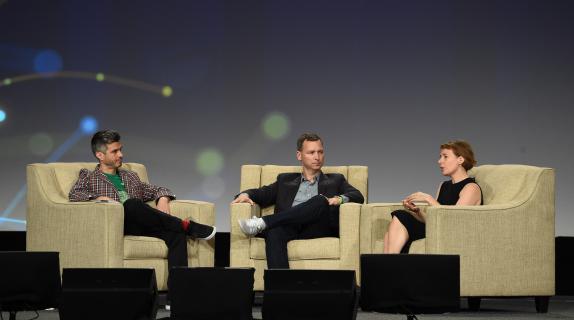As networks try to figure out their place in a digital world where those brands face declining resonance, there are opportunities for upstart marketers, said panelists on the “There’s an App for That” session at PromaxBDA: The Conference 2015 at the JW Marriott L.A. LIVE on Wednesday.
“There’s a huge gap in the marketplace for agencies who can give me end-to-end brand expertise, who can cut promos for me and take me all the way from the network to the Playstation platform,” said Evan Shapiro, executive VP, digital enterprises, NBCUniversal.
“There’s tremendous opportunity for people who are multi-taskers, who learn quickly and who can turn corners quickly,” said Christy Tanner, senior VP and general manager of CBS Interactive Media.
Another opportunity is being able to execute on the experience that’s being offered to consumers. An network is not the same as a Web site, which is not the same as an app.
“One of the biggest mistakes anyone could make in bringing their experience to an app environment is thinking that logo plus video equals answer,” said Matthew Evans, senior VP, digital, Viacom Kids and Family Group.
In fact, Nickelodeon represents the other side of the coin. While new digital environments are creating new opportunities for agencies that are willing to get in there and learn, they are making some networks more protective of their brands.
“At Nickelodeon, we made the decision that we’re the only ones who know the brand inside out to know the brand experience, so we’re doing most of it in-house,” said Evans. “We’re thinking about not just the digital organization but how the entire organization interrelates to these questions. It’s not just a digital and linear experience. Our audience doesn’t make that distinction.”
There also was recognition that audiences are becoming less attached to networks and more attached to talent.
“People are first and foremost loyal to shows, and in some cases, actors,” said Tanner. “They will follow actors and showrunners from show to show. Fans follow TV the way some people follow sports. Talent is at the center of the bulls’ eye whether that’s an actor or a showrunner.”
“Do you think those creators could carry their own SVOD service?” asked Shapiro. “When you look at niche networks like Revolt or El Rey as artist-driven brands, would they have been better served had they gone to an SVOD experience rather than a channel experience? My major issue with television is that you have to figure out what’s on at 2 p.m. on a Tuesday. That’s a frustrating and terrible experience because you have to pay money to put something on at 2 p.m.”
That’s another opportunity: creating curated experiences that consumers trust and return to again and again.
“I think there are times when you want to go to a supermarket and there are times when you want to go to a restaurant and those are two different experiences,” said Shapiro. “I like knowing that there’s an expert curator at the helm guiding my experience.
“I trust John Langraf at FX, for example. I know when I go to that network I’m always going to feel interested and intrigued and challenged, as opposed to an algorithm that says ‘we saw you watched this and we don’t have anything else so here’s Saved by the Bell.”
There are signs that upstart platforms like Netflix are taking a page from traditional networks’ books, running pre-roll promos prior to original series.
“Everyone freaked out because it looked like Netflix might be trying ads but really they are just running promos because they want people to watch their other shows,” said Shapiro. “If there’s a win for an agency it’s teaching in SVOD, OTT and so forth how to promote from one show to the next. Netflix is identifying a need in the marketplace.”
It also illustrates that marketers still do some things simply because they work.
“On-air promos are still big drivers,” said Tanner. “If you watch the big shows on TV, programs like The Voice still have the power to build awareness for big shows coming out in the summer or fall.”
Tanner also looks to other traditional marketing tools: “Key art is still really important. And promos have to be cut to run across all platforms.”
When marketers are considering all of these assets and all of these platforms, it’s important that they keep their brands’ one central concept in the forefront of their minds.
“Wherever a five-second promo or billboard appears, it all should return to one touchpoint. That one theory that drives the rest of your media is becoming more and more important,” said Shapiro.
“Trying to keep your message as simple as possible for the consumer to understand what they are going to get is super important,” said Tanner.
Still, keeping it simple is complex. Marketers need to take one idea and punch it across multiple platforms and formats all in the interest of developing one strong brand.
Said Shapiro: “Our industry tries to treat all of this as a binary conversation: It’s either on TV or it’s online. At the end of the day, it’s not either/or, it’s and.”
Image courtesy of Image Group LA.
Tags:













































__twocolumncontent.jpg)











